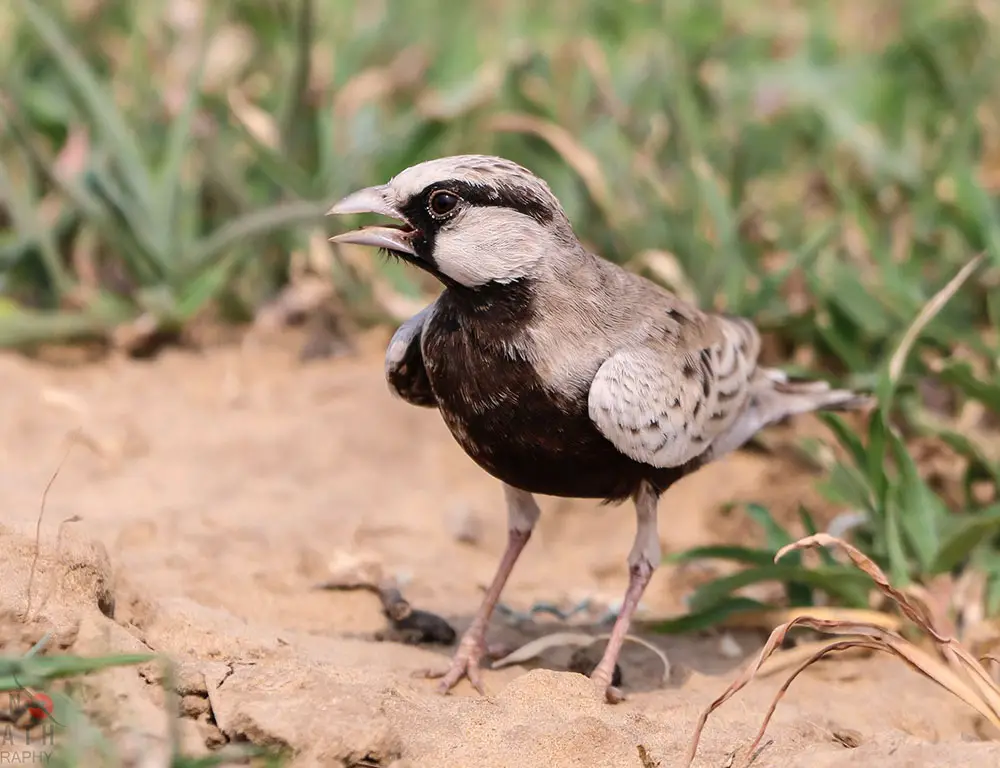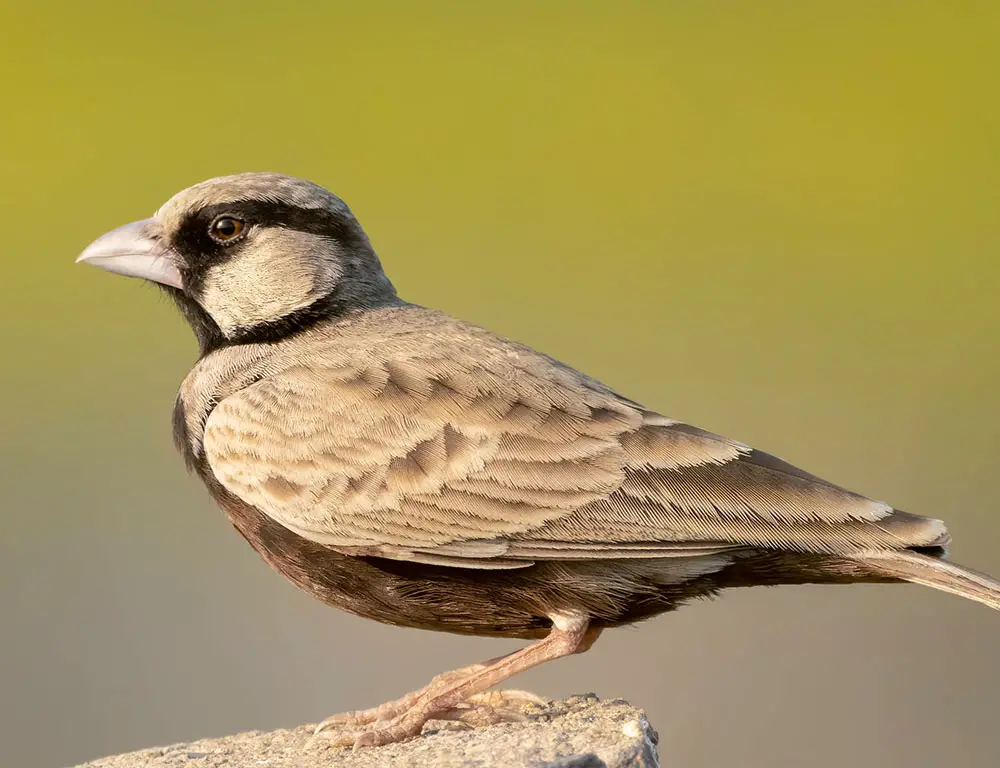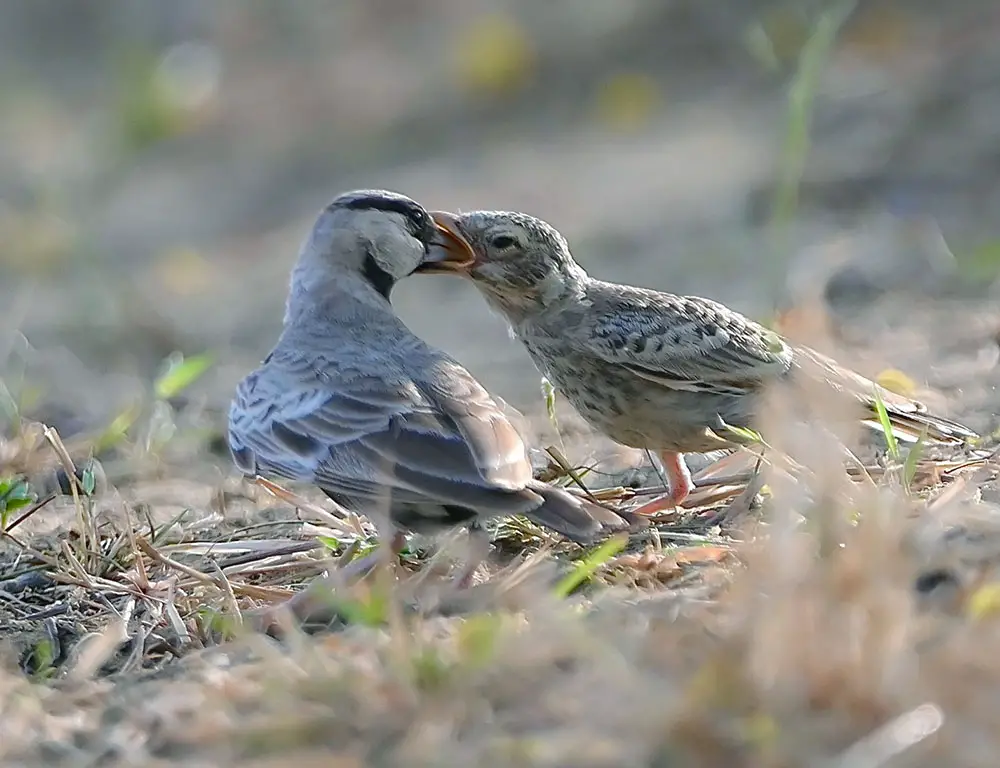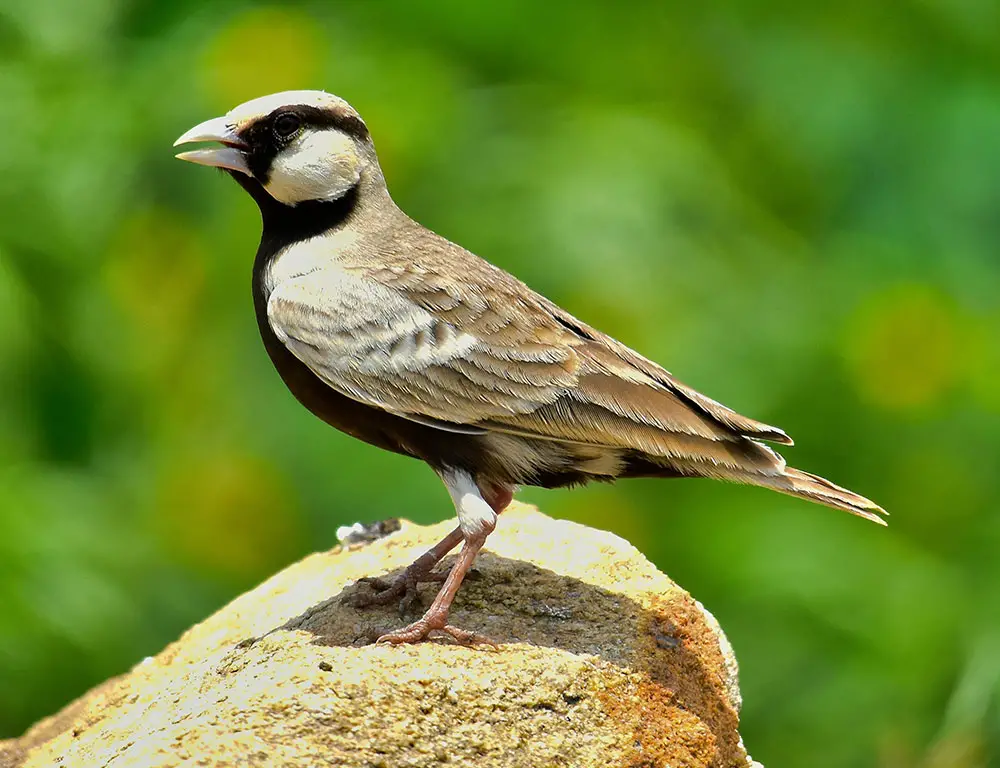If you’ve ever found yourself gazing at the sky, fascinated by the diverse avian life, you might have encountered a small yet intriguing bird species known as the Ashy-Crowned Sparrow-Lark.
Originating from the Indian subcontinent, this sparrow-like bird has captivated me with its unique behaviors and adaptations.
The Ashy-Crowned Sparrow-Lark is notable for its contrasting color patterns. Males are particularly striking with a dark brown body, stark white underparts, and an ashy grey crown – hence their name.
They’re mostly ground-dwelling birds, preferring dry habitats like grasslands and farmlands where they can find ample food. I must say it’s quite a sight to watch these birds skittering around on the ground in search of insects!
One fascinating aspect about them is their breeding behavior. Unlike many other bird species where females solely take on nest-building duties, both male and female Sparrow-Larks contribute to nest construction!
This equal partnership makes them stand out in the avian world. Suppose you’re a nature enthusiast like me or simply someone who appreciates the beauty of wildlife. In that case, delving deeper into Ashy-Crowned Sparrow-Larks will surely be an enriching experience.
Habitat and Distribution of the Ashy-Crowned Sparrow-Lark

The Ashy-Crowned Sparrow-Lark (Eremopterix griseus) is a bird species native to South Asia, with a wide geographical distribution across several countries, including India, Sri Lanka, Nepal, Bangladesh, and Pakistan.
Here’s a breakdown of its habitat preferences and distribution:
Geographical Range
The Ashy-Crowned Sparrow-Lark is commonly found in the dry region landscapes of South Asia, particularly in India, where it has a widespread presence.
It’s also common in Sri Lanka, with regular sightings in Bangladesh and frequent encounters in Pakistan. In Nepal, sightings are occasional.
Preferred Habitats
These birds predominantly inhabit open habitats such as grasslands, farmlands, agricultural fields, and sandy plains. They thrive in dry areas with sparse vegetation and loose soil, avoiding dense forests and high-altitude terrains.
Their preference for flatlands facilitates easy foraging and nesting.
Migration
While primarily sedentary within their home range, Ashy-Crowned sparrow larks exhibit local movements in response to weather changes, particularly variations in rainfall. During the breeding season, many individuals migrate to northwestern parts of India.
These migration patterns contribute to their adaptability and survival in diverse environments.
To give you a clearer picture of how widely these birds are spread out:
| Country | Presence |
| India | Widespread |
| Sri Lanka | Common |
| Nepal | Occasional sightings |
| Bangladesh | Regular sightings |
| Pakistan | Frequent encounters |
Physical Characteristics of the Ashy-Crowned Sparrow-Lark

The Ashy-Crowned Sparrow-Lark (Eremopterix griseus) possesses several distinctive physical characteristics that contribute to its unique appearance and adaptation to its environment:
Size
The Ashy-Crowned Sparrow-Lark typically measures 12 to 13 centimeters, slightly larger than the average sparrow.
Weight
These birds weigh between 20 and 25 grams on average, striking a balance between lightness for flight and stability against wind during ground activities.
Sexual Dimorphism
There is noticeable sexual dimorphism in coloration. Males display a striking color palette with a pale grey or ashy crown, dark brown upperparts, vibrant rufous underparts, and a contrasting black belly with white-tipped tail feathers.
In contrast, females and immature birds have more subdued earth-toned plumage to blend with their surroundings, providing better protection against predators.
Beak
The Ashy-Crowned Sparrow-Lark possesses a robust and conical-shaped beak adapted for feeding on seeds, which form a significant part of their diet.
Legs
Their longish legs are well-suited for terrestrial life, aiding in foraging on the ground and traversing various terrains.
Behavior and Diet of the Ashy-Crowned Sparrow-Lark

The Ashy-Crowned Sparrow-Lark (Eremopterix griseus) exhibits fascinating behaviors and dietary habits that reflect its adaptability and survival strategies:
Terrestrial Behavior
These birds are primarily terrestrial, spending much time on the ground. They engage in various activities, such as hunting insects and dust-bathing in dry soil patches.
Their flight pattern is straight with swift wingbeats, often flying low over the ground or vegetation.
Melodious Songs
Male Ashy-Crowned Sparrow-Larks are known for their melodic songs, which they use to serenade potential mates. They sing from prominent perches or during aerial displays, showcasing their innate musical prowess.
Dietary Habits
The Ashy-Crowned Sparrow-Lark has a diverse diet consisting mainly of insects and grains. They feed on insects such as beetles and ants and grains like millet seeds.
These birds have adapted well to human-influenced environments and can often be seen foraging in cultivated fields and meadows where grains are abundant.
Breeding Behavior
During the breeding season, Ashy-Crowned sparrow larks exhibit nest-building behavior. They construct compact nests on bare ground, concealed by vegetation or rocks. The female lays 2-3 eggs per clutch, and both parents share incubation duties.
Conservation Efforts for the Ashy-Crowned Sparrow-Lark

Conservation efforts for the Ashy-Crowned Sparrow-Lark (Eremopterix griseus) are crucial despite its current non-endangered status.
Here are some key initiatives aimed at protecting this species:
Habitat Protection
Organizations such as BirdLife International focus on safeguarding crucial bird habitats worldwide, including those inhabited by the Ashy-Crowned Sparrow-Lark. Efforts are made to preserve and restore natural habitats threatened by urbanization and habitat loss.
Community-driven Projects
Local communities in regions like India have initiated projects to preserve traditional grasslands, essential habitats for the Ashy-Crowned sparrow lark.
These projects involve planting native grasses and maintaining water bodies to support the birds and other wildlife dependent on these ecosystems.
Public Awareness
Raising public awareness about the Ashy-Crowned Sparrow-Lark and its conservation needs is essential. Educating communities about the importance of protecting their habitats and the threats they face can lead to increased support and involvement in conservation efforts.
Research
Scientific research plays a crucial role in understanding the behavior patterns, habitat preferences, and threats faced by the Ashy-Crowned Sparrow-Lark.
Research findings contribute to developing effective conservation strategies and management plans for the long-term protection of the species.
Conclusion
I’ve spent quite some time diving into the world of the Ashy-Crowned Sparrow-Lark, and I must say, it’s been an enlightening journey.
This bird species, native to India and Sri Lanka, showcases a unique blend of hardiness and adaptability that’s truly inspiring.
What stands out about these creatures is their striking visual appeal. The males, with their ashy crowns and contrasting black-and-pinkish belly patches, are a sight to behold. It’s no wonder they’re among their range’s most beautiful larks.
Their habitat preference also struck me as particularly fascinating. Preferring open lands like fields and grasslands over forests shows how these birds have adapted to survive in harsh conditions. These sparrows aren’t just survivors – they’re thrivers.
Yet what resonates with me the most is their song – a melody that defines them. They sing not just as a mating call but also to establish territory dominance. Their song isn’t merely heard; it’s felt, echoing across the plains they call home.
To sum up:
- The Ashy-Crowned Sparrow-Lark is visually stunning.
- They thrive in harsh habitats such as open fields and grasslands.
- Their song plays an integral part in their behavior patterns.
In my exploration of this remarkable species, I’ve learned that there’s so much more beneath their feathered surface than meets the eye.
The Ashy-Crowned Sparrow-Lark is a potent reminder of nature’s resilience and beauty – proof that life can flourish brilliantly even amidst adversity.
As we close this chapter on our avian friend, remember: Every creature has its story woven into the fabric of nature — complex, captivating narratives waiting for us to discover if only we take the time to look closer.